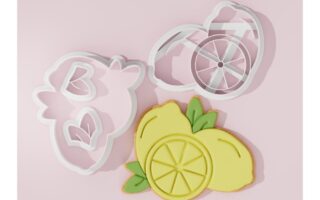In the world of culinary artistry, where precision meets creativity, the round pastry cutter stands out as an unsung hero. A humble yet indispensable tool in the kitchen, it transforms the simple act of cutting dough into an opportunity for innovation and design. Whether you’re crafting delicate pastries, perfecting the edges of a pie crust, or shaping flawless biscuits, this versatile implement allows both novice bakers and seasoned chefs to express their culinary vision with ease. This article delves into the history, functionality, and tips for using the round pastry cutter, uncovering why it deserves a special place in every home baker’s toolkit. Join us on a journey to explore how this circular cutter brings both form and flair to baked creations.
Table of Contents
- Exploring the Versatility of Round Pastry Cutters in the Kitchen
- Choosing the Right Material for Optimal Performance
- Culinary Techniques: Mastering the Art of Pastry Cutting
- Care and Maintenance Tips for Longevity and Excellence
- Q&A
- The Way Forward
Exploring the Versatility of Round Pastry Cutters in the Kitchen
Round pastry cutters are a kitchen essential that go far beyond mere dough preparation. Their versatility allows them to streamline various cooking tasks, making them a must-have for both novice bakers and seasoned chefs. These handy tools can be employed to create perfect circles of pastry for tarts and pies, but their utility doesn’t end there. Use them to craft delightful cookies, portion out precise servings of appetizers, or even cut out vegetables for garnishing. The possibilities are endless, as the simple round shape lends itself beautifully to any culinary creation.
When selecting pastry cutters, consider a range of sizes and materials to suit your specific needs. Here are some popular uses for round pastry cutters:
- Cookie making: Achieve uniform cookie shapes for even baking.
- Pasta shaping: Cut circular pasta sheets for ravioli or tortellini.
- Fruit garnishes: Create beautiful fruit medallions for desserts and platters.
- Canapés: Craft bite-sized appetizers for parties and gatherings.
To illustrate their utility, let’s look at a simple comparison of different materials:
| Material | Benefits | Best For |
|---|---|---|
| Stainless Steel | Durable and easy to clean | All-purpose baking |
| Plastic | Lightweight and colorful | Kids’ baking projects |
| Silicone | Non-stick surface | Delicate pastries and doughs |
By incorporating several types of round pastry cutters into your kitchen toolkit, you can elevate your cooking experience and unleash your creativity. Whether you’re preparing a special occasion treat or an everyday meal, these cutters make a world of difference!
Choosing the Right Material for Optimal Performance
When selecting the ideal material for a round pastry cutter, consider how it influences both the cutting performance and the longevity of the tool. Stainless steel is a popular choice among professionals and home bakers alike due to its durability and resistance to rust. It provides a clean cut, ensuring that dough retains its shape, which is essential when crafting perfectly round pastries. Plastic cutters, on the other hand, offer a lighter option and are often available in a variety of colors, appealing to those who prioritize aesthetics. However, they may not be as effective with thicker or tougher doughs. Here are some materials to keep in mind:
- Stainless Steel: Durable and sharp, minimizes dough sticking.
- Plastic: Lightweight and colorful, but may lack cutting power.
- Silicone: Non-stick, great for delicate pastries; flexible for easy release.
Understanding the temperature and texture of the dough you typically work with will also guide your choice. Certain materials perform better under specific conditions. For instance, if you frequently deal with chilled dough, metal cutters maintain their shape and sharpness even when cold, preventing the dough from mashing. Likewise, silicone offers flexibility, making it easier to remove pastry without damaging it. To better illustrate this choice, consider the following table:
| Material | Best For | Pros | Cons |
|---|---|---|---|
| Stainless Steel | All dough types | Durable, sharp, easy to clean | Can be heavy for some users |
| Plastic | Soft dough | Lightweight, colorful | Less effective on thick dough |
| Silicone | Delicate pastries | Non-stick, flexible | May not cut through tough doughs |
Culinary Techniques: Mastering the Art of Pastry Cutting
Mastering the art of pastry cutting requires both practice and the right tools. A round pastry cutter is a versatile instrument that simplifies the process of cutting dough into uniform shapes, allowing bakers to create beautifully presented treats. When using a pastry cutter, consider the following techniques to enhance your skills:
- Consistent Pressure: Apply even pressure while cutting to avoid distortion in the dough.
- Chilling the Dough: Ensure that the dough is well-chilled before cutting, as this prevents it from becoming too sticky.
- Rotate for Shape: For varied sizes, simply rotate the cutter while pressing down to achieve a perfect circle.
To optimize your pastry cutting experience, it’s beneficial to understand the different sizes and functions of round pastry cutters. Below is a simple comparison table to help you choose the right cutter for your baking projects:
| Size | Use Case | Recommended For |
|---|---|---|
| 2-inch | Mini pastries | Cookies and tarts |
| 3-inch | Standard size | Pies and quiches |
| 4-inch | Large pastries | Savory galettes |
Care and Maintenance Tips for Longevity and Excellence
To ensure your round pastry cutter maintains its sharpness and shape, cleaning immediately after use is essential. Wipe the cutter with a damp cloth to remove any dough residue, and avoid soaking it in water, as prolonged exposure can compromise the integrity of the materials. For stubborn bits of dough, use a non-abrasive scrubber, and dry thoroughly before storing. Additionally, consider storing your pastry cutter in a protective case or a drawer with a soft lining to prevent accidental nicks and scratches.
Regular inspections can help identify wear and tear early, prolonging the life of your cutter. Make it a habit to check for bent blades or loose fittings. If your cutter features a wooden handle, periodically apply a food-safe mineral oil to keep the wood conditioned and prevent cracking. For metal cutters, a mild stainless steel cleaner can keep it shining bright while reducing tarnish. Below is a simple table summarizing essential care tips:
| Care Tip | Frequency |
|---|---|
| Clean After Use | Always |
| Check for Wear | Monthly |
| Condition Wooden Handles | Every 3-6 Months |
| Use Stainless Steel Cleaner | As Needed |
Q&A
Q&A: Round Pastry Cutter – Your Essential Baking Tool
Q: What is a round pastry cutter?
A: A round pastry cutter is a handheld kitchen tool primarily used to cut dough into uniform circles. It typically features a circular, sharp-edged blade attached to a ergonomic handle for ease of use. It’s a staple for bakers, whether you’re making biscuits, scones, or pie crusts.
Q: How do I choose the right size round pastry cutter for my baking needs?
A: Round pastry cutters come in various sizes, typically ranging from small (about 2 inches) to large (up to 5 inches or more). The size you choose depends on the recipe requirements and the type of baked good you’re preparing. For cookies, a medium cutter usually works best, while larger cutters are ideal for pies and tarts.
Q: Can a round pastry cutter be used for tasks beyond cutting dough?
A: Absolutely! While its primary function is to cut dough, a round pastry cutter can also be used for crafting perfectly circular shapes from fondant, cutting pancakes, or even slicing soft fruits like melons. Its versatility makes it a valuable tool in any kitchen.
Q: What materials are round pastry cutters made from?
A: Most round pastry cutters are made from stainless steel, which offers durability and easy cleaning. However, you can also find plastic or silicone options, which can be gentler on non-stick surfaces, though they may not be as sharp as their metal counterparts.
Q: How do I maintain my round pastry cutter?
A: To keep your round pastry cutter in optimal condition, clean it with warm, soapy water after each use and avoid abrasive cleaning tools that may scratch the surface. If it’s made of stainless steel, a gentle polish can maintain its shine over time.
Q: Can I use a round pastry cutter for other cuisines?
A: Yes! While round pastry cutters are often associated with Western baking, they can be used in various cuisines. From cutting out dumpling wrappers to creating perfectly shaped dough for Asian bao, the round pastry cutter fits seamlessly into a multitude of culinary traditions.
Q: Are there any tips for using a round pastry cutter effectively?
A: To achieve the best results, always ensure your dough is adequately chilled and floured before cutting. Press down firmly and avoid twisting the cutter, as this can seal the edges and hinder rising during baking. For the cleanest circles, use a quick, straight motion.
Q: Where can I purchase a quality round pastry cutter?
A: Round pastry cutters are widely available in kitchen supply stores, big-box retailers, as well as online marketplaces. Look for reputable brands that offer quality materials for longevity and performance. User reviews can also guide you to the best options suited for your needs.
—
Feel free to incorporate any additional questions you find relevant as you explore the delightful world of baking with round pastry cutters!
The Way Forward
As we conclude our exploration of the round pastry cutter, it becomes clear that this seemingly simple tool holds a significant place in the heart of baking and culinary arts. Whether you’re a seasoned pastry chef or an enthusiastic home cook, investing in a quality round pastry cutter can elevate your creations, making each pie, tart, or cookie a visual and gustatory delight. From perfectly shaped dough circles to achieving uniformity in your baked goods, this little gadget proves that great things often come in small packages.
So, as you roll out your dough and prepare to craft your next masterpiece, remember the invaluable role of the round pastry cutter. Embrace its versatility, experiment with it in your recipes, and let your imagination take flight. After all, in the world of baking, the right tools can unlock boundless creativity, transforming the ordinary into the extraordinary. Happy baking!



